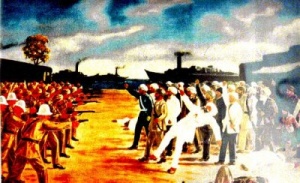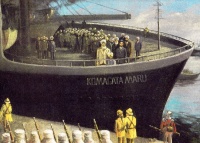Arrival of the Ship at Budge Budge
The Komagata Maru approached Calcutta on September 26, 1914. As it approached Calcutta, a European gunboat signaled the ship to stop. The ship was put under guard and the passengers were held as prisoners. Then the Komagata Maru was taken to a place called Budge Budge, about seventeen miles away from its original destination of Calcutta.
These new developments took the passengers of the ship by surprise. After two months of litigation in Canada they were not interested in any new developments of this kind. Upon inquiry by Baba Gurdit Singh as to the change of their course, an official informed him that the passengers were being sent to Punjab via a special train.
Many of the passengers did not want to go to Punjab. They had business to attend to in Calcutta, some wished to look for work there, and most importantly, the passengers wanted to place the Guru Granth Sahib, which they had taken with them on their journey, in a Calcutta Gurdwara.
On 29 September, 1914 at 11AM, the Komagata Maru reaches the town of Budge Budge 27 Kilometers from Calcutta and the passengers are forced to disembark the ship. Officials call additional police and military to enforce the order. The passengers wanted to return to Calcutta but were forced against their wishes.
It appeared to be a deliberate ploy by the British. Subsequently, a riot breaks out. Of the 321 passengers on the ship at Budge Budge, 20 passenger are killed; 1 is drowned; 9 were hospitalized, 202 jailed and 28 remained unaccounted for and 62 leave for Punjab. A number of passengers, including Gurdit Singh escape.
The Scenario of firing…A Melee
In a communication from Lord Hardinge, the Viceroy of Bengal Governor in connection with the release of detenues, it was observed that those who had been detained primarily because they had suffered injuries in the occurrence, may in fact be innocent since in a melee such as took it is quite as likely as a guilty man to have been wounded, perhaps more so".
UNFOLDING OF THE EVENT
"After some conversation with Sir William Duke, who had gone out and persuaded the Sikhs to return to Budge, we went forward on foot and arrived at the Railway Station just as the Sikhs reached it and were sitting down. Then occupied the road parallel to on the west side of the railway, for which they were separated by an iron railing about four feet high.
Mr. Donald on arrival, asked for Gurdit Singh who was pointed out to him at the end of the crowd next to the station. It was rather dark by this time, but it was possible to see a man's features if one looked closely. Gurdit Singh showed no disposition to move and one or two European sergeants stepped forward. I presume to fetch (read apprehend) him.
Immediately all the Sikhs round Gurdit Singh sprang to their feet and closed round him. The excitement seemed to be spreading to other people who were farther away and who could not possibly have known the cause of it. I moved off several paces to my own left, attempting to pacify these people and asking them to sit down and keep calm, immediately a shot was fired. The flash caught my eye and I should say it came from behind.
Gurdit Singh and to his right that is nearer to the level crossing. No sooner had the first shot been fired, a larger number of others followed. The European desargeants started firing, the crowd broke and a swayed, some individuals of them charging forward to attack the police. I had a Browning pistol in my pocket and I drew it and fired seven shots at people who were advancing on me.
I was standing near the level crossing and a good deal of hot hand-to-hand fighting took place between Sikhs and some men of the Punjab Police. It was in this early part of the scuffle that I received two bullet wounds, one in the right forearm and other one in the upper thigh. The next impression I have is that the Sikhs were gathered in force round the huts on the left hand side of the road as one goes from the level-crossing towards the river.
They were tearing away the 'bamboos' of which the huts were composed, presumably to use them as 'lathis'. A good a many shots were fired from about these huts. After making one or two abortive rushes forward, the Sikhs broke and fled. The troops had been standing in columns of fours some short distance behind at the time the riot commenced, and from the confident and the daring way in which the Sikhs attacked I feel sure that they were not aware of the presence of soldiers.
In my opinion some 40 or 50 shots might have been fired by the rioters and they may have used about 10 or 12 pistols. I saw no Winchester rifles and no swords, but as the rioters were grappling with men of the Punjab Police it is quite possible they succeeded in capturing one or two swords from injured policemen." (D. Petrie)
Did the passengers have any weapons?
Going through all of the reports, only one .38 pistol was found on the spot, along with some empty cartridges of the same bore, which says could have belonged to the passengers since neither one pistol of the same bore was recovered from one of the passengers at Midnapur which may be not palpable link with the said 'riot'.
But what is left unsaid is that none from among the police officials, including D. Petrie, had seen any of the passengers wielding a fire arm. The simple recovery of a particular weapon from the spot cold mean many things.
Above all, if the passengers had possessed weapons and fired them from point blank range, in the middle of a melee, the casualties of the police officials would, most likely, been been much higher. The fact is that, the officials hit by firearms, could have been hit by a bullet or bullets passing through several people, particularly in the case of a high velocity rifle. Besides, the accuracy of a pistol is very limited. Hence, the wounds to the officials were, in all likelihood fired, from the officials themselves. There was no ballistic comparisons made on the bullets recovered from the bodies of the official side, which certainly gives one a reason to ask why not?
Status of Passengers
The section below is from an article by By Prof. Malwinder Jit Singh, Advocate. (several searches have not revealed a date when this piece was published)
The status of passengers as on 11th Oct, 1914: Total=321
Left for Panjab in special train = 59 Left behind, women & children = 3
Balance = 259
Killed at Budge Budge = 16
Died from wounds in Hospital = 2
Found drowned = 1
Balance = 168
In hospital in Calcutta = 9
In jail in Calcutta = 168
" " outside " = 24
________________________________
Total = 201
Balance still to be accounted for = 39
| Part of a series on Komagata Maru |
Komagata Maru |
DAMAGE ON THE OFFICIAL SIDE DUE TO "RIOT"
Killed……….= 3 police personnel +1 Railing employee, presumably due to Army firing.
Injured………=11 (5 due to bullet injuries and other due to non-firearm injuries)
See also
References
By Prof. Malwinder Jit Singh Advocate. KOMAGATA MARU EPISODE: Firing on hopeless passengers on 29th April 1914 at Budge Budge Ghat-Calcutta


